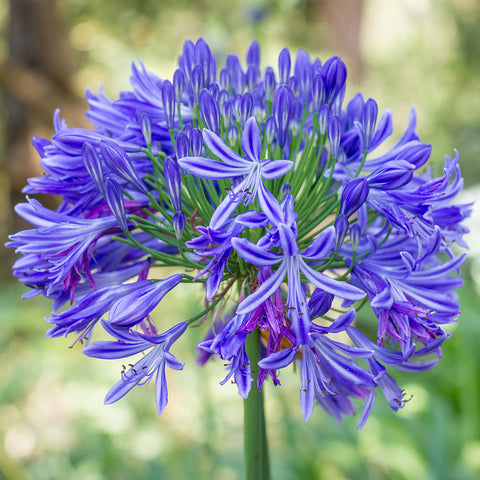Seasonal Agapanthus Treatment: Getting Ready For Winter and Summer season
Seasonal Agapanthus Treatment: Getting Ready For Winter and Summer season
Blog Article
Letting Loose the Secret to Successful Agapanthus Farming: Idea for a Flourishing Yard
In the realm of horticulture, cultivating agapanthus successfully needs a strategic technique that incorporates different facets of plant care. By understanding the subtleties of agapanthus farming, one can develop an environment where these plants flourish and grow perfectly.
Planting Agapanthus: Ideal Practices
When planting Agapanthus, proper dirt prep work is crucial for guaranteeing effective growth and development of these gorgeous blossoms. Agapanthus, typically referred to as Lily of the Nile or African lily, thrives in well-draining dirt with a somewhat acidic to neutral pH degree - Agapanthus. Before growing, it is vital to change heavy clay dirts with organic matter such as garden compost or peat moss to enhance drain and give important nutrients for the plants
To plant Agapanthus, choose a location that obtains full sunlight to partial shade, as this will certainly promote healthy growth and abundant flowering. Dig a hole twice the size of the plant's root ball and place the Agapanthus at the same deepness it was previously growing. Delicately backfill the opening with soil, pushing down strongly to get rid of any air pockets around the origins.
Water the recently planted Agapanthus extensively and continue to maintain the dirt evenly wet, specifically throughout the plant's active expanding period. Agapanthus. Applying a well balanced plant food once a month can additionally support the plant's development and flowering. By following these finest techniques for growing Agapanthus, you can create a magnificent display of these exciting blossoms in your yard
Ideal Dirt Conditions for Agapanthus
For ideal development and blooming success of Agapanthus plants, guaranteeing the dirt problems are optimal is important. Agapanthus favors dirt that is rich in nutrients, so integrating a well balanced fertilizer during the expanding period can advertise healthy development and dynamic blooms.

Watering and Feeding Tips
To make sure healthy development and dynamic blooms, proper watering and fertilizing techniques are vital for effective Agapanthus cultivation. Agapanthus plants benefit from normal watering, particularly during the expanding season.
When it involves fertilizing Agapanthus, a balanced plant food with equivalent components nitrogen, phosphorus, and potassium can be applied in the spring to advertise healthy growth and blooming. Slow-release fertilizers are perfect for offering nutrients progressively over a prolonged duration. Stay clear of over-fertilizing, as this can lead to extreme vegetation development at the cost of blossoms.
In addition, integrating raw material like garden compost right into the dirt can enhance nutrient degrees and improve dirt structure, aiding in the general health of the Agapanthus plants. By following these watering and fertilizing suggestions, gardeners can guarantee their Agapanthus plants thrive and create magnificent display screens of flowers.
Pruning and Deadheading Techniques
Proper trimming and deadheading methods play a crucial duty in keeping the health and wellness and appearances of Agapanthus plants, complementing the important practices of watering and feeding for successful farming. Trimming Agapanthus entails getting rid of invested flower heads, yellowing or dead leaves, and overall shaping of the plant to promote better growth. Deadheading, the procedure of eliminating discolored blossoms, not only enhances the plant's appearance yet additionally urges more flowering.
When deadheading Agapanthus, it is advisable to trim off the flower stem at the base using sharp, tidy shears. This procedure redirects the plant's power from seed manufacturing back right into root and vegetation growth, promoting a healthier and more durable plant. Regular deadheading can prolong the growing period of Agapanthus and prevent self-seeding, which can cause overcrowding.
In click to read terms of check over here pruning, Agapanthus usually take advantage of a light trim after flowering to tidy up the plant and motivate fresh development. Reducing back the spent blossom stems and eliminating any dead or damaged foliage assists preserve the plant's vigor and total appearance. However, it is crucial to avoid cutting into the crown of the plant, as this can damage its wellness.

Protecting Agapanthus From Pests and Diseases
Executing reliable bug and condition management strategies is important to safeguarding the wellness and vitality of Agapanthus plants in cultivation. Agapanthus are generally durable plants, yet they can still come down with various bugs and illness if not correctly cared for. One typical parasite that impacts Agapanthus is the Agapanthus borer, a caterpillar that tunnels right into the plant, creating damages to the blossoms and fallen leaves. To stop invasions, normal examination of the plants is necessary. If borers are found, they can be by hand gotten rid of, or insecticidal soap can be used as a control procedure.
In addition to insects, Agapanthus are at risk to conditions such as root rot and fungal fallen leave areas. By remaining cautious and addressing parasite see and illness issues quickly, gardeners can assist their Agapanthus thrive and flourish.

Final Thought
Finally, successful farming of agapanthus needs proper growing strategies, ideal dirt conditions, appropriate watering and fertilizing, regular pruning and deadheading, and defense from conditions and pests. By adhering to these tips and techniques, gardeners can guarantee a prospering yard loaded with lovely agapanthus flowers. Agapanthus. Remember to preserve constant treatment and attention to information to promote the health and wellness and long life of these sensational plants
When planting Agapanthus, correct soil prep work is crucial for guaranteeing effective development and advancement of these attractive flowers.Water the newly planted Agapanthus thoroughly and proceed to maintain the dirt uniformly moist, specifically throughout the plant's energetic growing period.For ideal development and growing success of Agapanthus plants, making sure the dirt problems are perfect is crucial. When growing or transplanting Agapanthus, make sure the soil is well-prepared to offer the necessary structure for the plants to establish themselves effectively. One usual bug that influences Agapanthus is the Agapanthus borer, a caterpillar that passages right into the plant, creating damages to the fallen leaves and flowers.
Report this page